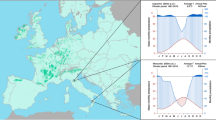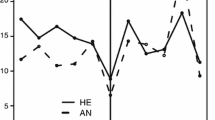Abstract
In this paper we examine the influence of precipitation and temperature deviations on regional volume growth rates in even-aged, unmanaged second-growth Douglas fir (Pseudotsuga menziesii [Mirb.] Franco) stands. Between 1969 and 1986, average volume growth rates in natural stands of coast Douglas fir in western Washington and Oregon were negatively correlated with high summer temperatures and positively correlated with higher temperatures during the non-growing season. Results support the hypothesis that cool wet summers and mild winters contribute to high productivity of conifers in the Pacific Northwest.
Similar content being viewed by others
References
Blasing, T.J., Duvick, D.N. and West, D.C.: 1981, Tree-Ring Bull. 41, 37.
Brubaker, L.B.: 1980, Ecology 61, 798.
Emmingham, W.H. and Waring, R.H.: 1977, Can. J. For. Res. 7. 165.
Franklin, J.F. and Dyrness, C.T.: 1973, Natural vegetation of Oregon and Washington. USDA For. Serv. Gen. Tech. Rep. PNW-8. 417 pp.
Graumlich, L.J., Brubaker, L.B. and Grier, C.C.: 1989, J. Ecol. 70, 405.
Griffith, B.G.: 1960, Growth of Douglas fir at the University of British Columbia Research Forest as related to climate and soil. Forestry Bulletin No. 2, University of British Columbia, Vancouver, B.C. 58 pp.
Hazard, J.W. and Peterson, C.E.: 1984, Objectives and analytical methods of the Regional Forest Nutrition Research Project. Institute of Forest Resources, Contrib. 53, University of Washington, Seattle, WA. 23 pp.
King, J.E.: 1966, Site index curves for Douglas fir in the Pacific Northwest. Weyerhaeuser For. Pap. 8. 49 pp.
Lassoie, J.P., Hinckley, T.M. and Grier, C.C.: 1985, Coniferous forests of the Pacific Northwest. Physiological Ecology of North American Plant Communities. Chapman and Hall, New York.
McArdle, R.E., Meyer, W.H. and Bruce, D.: 1930, The yield of Douglas fir in the Pacific Northwest. USDA Tech. Bull. 201. 74 pp.
Miller, R. E., Barker, P. R., Peterson, C. E. andWebster, S. R.:1986, Using nitrogen in the management of Douglas fir, i. regional trends of response, in Douglas fir: Stand Management for the Future, Proceedings of symposium held in June, 1985University of Washington, Seattle, WA.
Peterson, C.E. and Hazard, J.W.: For. Sci., in press.
Peterson, C.E. and Ryan, P.J. and Gessel, S.P.: 1984, Soil Sci. Soc. Am. J. 48, 162.
Schumacher, F.X. and Meyer, H.A.: 1937, J. Agric. Research 54, 79.
Turnbull, K.J., Little, G.R. and Hoyer, G.E.: 1972, Comprehensive treevolume tarif tables. State of Washington, Dept. Of Natl. Resources, Olympia, WA.
United States Environmental Data Service: 1969-1986, Climatological data. State of Washington. United States Dept. of Commerce, Washington, D.C.
Author information
Authors and Affiliations
Rights and permissions
About this article
Cite this article
Peterson, C.E., Heath, L.S. The influence of weather variation on regional growth of Douglas fir stands in the U.S. Pacific Northwest. Water Air Soil Pollut 54, 295–305 (1990). https://doi.org/10.1007/BF00298673
Issue Date:
DOI: https://doi.org/10.1007/BF00298673




